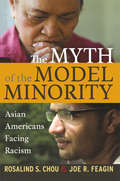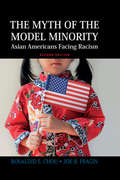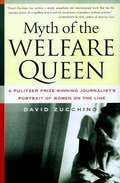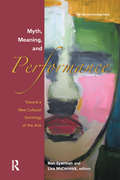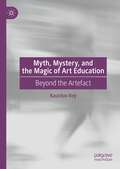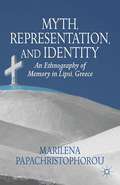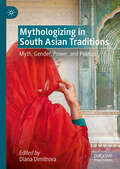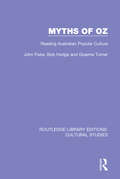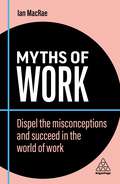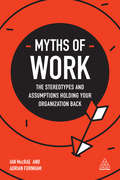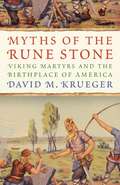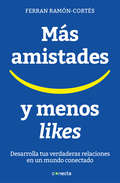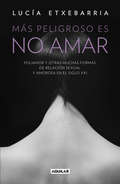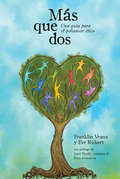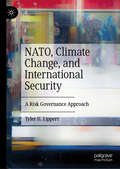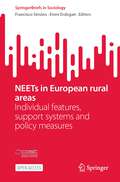- Table View
- List View
Myth of Universal Human Rights: Its Origin, History, and Explanation, Along with a More Humane Way
by David N. StamosIn this groundbreaking and provocative new book, philosopher of science David N. Stamos challenges the current conceptions of human rights, and argues that the existence of universal human rights is a modern myth. Using an evolutionary analysis to support his claims, Stamos traces the origin of the myth from the English Levellers of 1640s London to our modern day. Theoretical defenses of the belief in human rights are critically examined, including defenses of nonconsensus concepts. In the final chapter Stamos develops a method of naturalized normative ethics, which he then applies to topics routinely dealt with in terms of human rights. In all of this Stamos hopes to show that there is a better way of dealing with matters of ethics and justice, a way that involves applying the whole of our evolved moral being, rather than only parts of it, and that is fiction-free.
Myth of the Model Minority: Asian Americans Facing Racism
by Joe R. Feagin Rosalind S. ChouWith their apparent success in schools and careers, Asian Americans have long been viewed by white Americans as the "model minority." Yet few Americans realize the lives of many Asian Americans are constantly stressed by racism. This reality becomes clear from the voices of Asian Americans heard in this first in-depth book on the experiences of racism among Asian Americans from many different nations and social classes. Chou and Feagin assess racial stereotyping and discrimination from dozens of interviews across the country with Asian Americans in a variety of settings, from elementary schools to colleges, workplaces, and other public arenas. They explore the widely varied ways of daily coping that Asian Americans employ-some choosing to conform and others actively resisting. This book dispels notions that Asian Americans are universally "favored" by whites and have an easy time adapting to life in American society. The authors conclude with policy measures that can improve the lives not only of Asian Americans but also of other Americans of color.
Myth of the Model Minority: Asian Americans Facing Racism, Second Edition
by Joe R. Feagin Rosalind S. ChouFirst Published in 2016. Routledge is an imprint of Taylor & Francis, an Informa company.
Myth of the Social Volcano
by Martin WhyteWhyte (sociology, Harvard U. ) examines how ordinary Chinese citizens weight the balance between a booming economy and rising inequality as they evaluate the social order. He suggests that given the changes from socialist to market economy and from modest to sizeable income gaps, people's attitude may well effect China's future political stability. Among his topics are China's post-socialist transition and rising inequality, what Chinese citizens see as fair and unfair about current inequalities, preferences for equality and inequality, and views of stratification and class conflict. His detailed survey data show that gleeful predictions that an angry populace is on the verge of overthrowing the state are just wishful thinking. Annotation ©2010 Book News, Inc. , Portland, OR (booknews. com)
Myth of the Welfare Queen: A Pulitzer Prize-winning Journalist's Portrait of Women on the Line
by David ZucchinoPulitzer Prize-winning reporter David Zucchino spent a year sharing the lives of Odessa Williams and Cheri Honkala -- two "welfare mothers" in Philadelphia -- to gain an intimate look at their day-to-day existence. Odessa, supporting an extended family, exhibits almost superhuman strength and resolve. Cheri, a single mother, is a tireless advocate for the homeless. Zucchino beautifully portrays them as figures of profound courage and quiet perseverance, systematically shattering all misconceptions and stereotypes about these women and so many others like them.
Myth, Meaning and Performance: Toward a New Cultural Sociology of the Arts
by Ronald Eyerman Lisa McCormickThe cultural and performative turns in social theory have enlivened sociology. For the first time these new developments are fully integrated into new approaches to the sociology of the arts in this important new book. Building on the established research into art worlds, what is interesting for the new sociology of the arts, understood in the broad sense to include popular culture as well the classical focus on music, painting, and literature, is the relationship between art works and meaning, myth, and performance. Also reflected in these rich essays, which range from Beethoven to John Lennon to Chinese avant garde artists, is the lived experience of the artist and its impact on the process of creation and innovation.
Myth, Mystery, and the Magic of Art Education: Beyond the Artefact
by Kaustuv RoyThis book provides a new understanding of art education, connecting art, necessity, and pedagogy. Plenty has been written about art education, but its potential contribution to inner autonomy and existential emancipation due to the re-articulation of time and space in art has not been adequately explored in a pedagogic context. This book explores art as an affective continuum--not a plaything of culture, but rather a mode of alignment of the existential Eros with our ontological truth.
Myth, Representation, and Identity: An Ethnography of Memory in Lipsi, Greece
by M. PapachristophorouLipsi forms a modern construction that has disconnected from its past. Recently, the community has formed a collective identity reconstructed from fragments of collective memory. This book is an ethnographic account of the mythology proposed by the community and examines how history and collective memory tightly interconnect.
Myth, Society and Profanation (Routledge Studies in Social and Political Thought)
by William PawlettThis work challenges the dominant pejorative view of myth by showing how myth is implicated in the deepest layers of society, politics, individuality and temporality.This work draws upon European cultural theorists, particularly Schelling, Nietzsche, Freud, Bataille and Baudrillard, to challenge the dominant pejorative view of myth. It argues that myth has been subjected to an intensive process of profanation yet nevertheless is always implicated in society, politics and temporality. The work examines sacred dimensions of myth, the modern myth of desire and some cultural effects of the profanation process.The intended audience is undergraduate and postgraduate students in the Humanities, Arts and Social Sciences.
Mythologizing in South Asian Traditions: Myth, Gender, Power, and Politics
by Diana DimitrovaThis book deals with the issue of mythologizing in South Asian traditions. It brings together a number of essays dealing with the interface between mythology, gender, politics, and nationalism. The common thread that links the chapters is the appropriation and reinterpretation of myth, and its weaponizing for the purpose of power or political gain. All chapters explore the various aspects of the ongoing process of re-mythologizing of the present, as revealed in South Asian traditions. The essays in this collection respond to the same question: how to interpret the present? What is the meaning of ancient and venerated myths today? What are the ideological implications of the interpretation of myths and how do they reflect and influence the power structures of contemporary societies in South Asia?
Myths of Modernity: Peonage and Patriarchy in Nicaragua
by Elizabeth DoreIn Myths of Modernity, Elizabeth Dore rethinks Nicaragua's transition to capitalism. Arguing against the idea that the country's capitalist transformation was ushered in by the coffee boom that extended from 1870 to 1930, she maintains that coffee growing gave rise to systems of landowning and labor exploitation that impeded rather than promoted capitalist development. Dore places gender at the forefront of her analysis, which demonstrates that patriarchy was the organizing principle of the coffee economy's debt-peonage system until the 1950s. She examines the gendered dynamics of daily life in Diriomo, a township in Nicaragua's Granada region, tracing the history of the town's Indian community from its inception in the colonial era to its demise in the early twentieth century. Dore seamlessly combines archival research, oral history, and an innovative theoretical approach that unites political economy with social history. She recovers the bygone voices of peons, planters, and local officials within documents such as labor contracts, court records, and official correspondence. She juxtaposes these historical perspectives with those of contemporary peasants, landowners, activists, and politicians who share memories passed down to the present. The reconceptualization of the coffee economy that Dore elaborates has far-reaching implications. The Sandinistas mistakenly believed, she contends, that Nicaraguan capitalism was mature and ripe for socialist revolution, and after their victory in 1979 that belief led them to alienate many peasants by ignoring their demands for land. Thus, the Sandinistas' myths of modernity contributed to their downfall.
Myths of Oz: Reading Australian Popular Culture (Routledge Library Editions: Cultural Studies #Vol. 2)
by John Fiske Graeme Turner Bob HodgeThis book, first published in 1987, sets out to examine and extend our understanding of Australian popular culture, and to counter the long-established, traditional criticism bewailing its lack. The authors argue that the 'knocker's' view started from an elitist viewpoint, yearning for Australia to aspire to a European culture in art, music, literature and other traditional cultural fields. They argue however that there are other definitions of culture that are more populist, more comprehensive, and which represent a vitality and dynamism which is a true reflection of the lives and aspirations of Australians. Myths of Oz offers no comprehensive definition of Australian culture, but rather a way of interpreting its various aspects. The barbeque or the pub, an expedition to the shops or a day at the beach, the home, the workplace or the job queue; all these intrinsic parts of Australian life are examined and conclusions drawn as to how they shape or are shaped by what we call popular culture. The authors look too at monuments and symbols, from Ayers Rock to the Sydney Opera House, which both shape and reflect Australian culture, while a chapter on the Australian accent shows how language and terminology play a powerful role in establishing cultural standpoints. A particular strength of this book is that while delivering a provocative and stimulating series of viewpoints on popular culture, it also makes use of current academic tools and methodology to ensure that we gain new insights into the meanings and pleasures we derive from our everyday experiences.
Myths of Work: Dispel the Misconceptions and Succeed in the World of Work (Business Myths)
by Ian MacRaeBuying a table tennis table will make your staff happier. Working eight hours a day, five days a week, will result in the most productivity. Paying higher salaries will always result in higher motivation. But will it really?There are a staggering number of myths, stereotypes and out-of-date rules that abound in the workplace. This can make it feel impossible to truly know how to get the most out of your career, your team and your company. In Myths of Work, Ian MacRae take an entertaining and evidence-based look at the most pervasive myths about our working lives, from the serious to the ridiculous, to give you the insight you need to become a better manager in the modern workplace. Fascinating real life case studies from organizations around the world display the myths (and how to overcome them) in practice.Myths of Work combines business thinking with psychology to give you practical insights, a lively writing style and a handy dip-in-and-out structure to form your ultimate guide to becoming a better and enlightened manager.About the Business Myths series...The Business Myths series tackles the falsehoods that pervade the business world. From leadership and management to social media and the workplace, these accessible books overturn out-of-date assumptions, skewer stereotypes and put oft-repeated slogans to the myth-busting test. Both entertaining and rigorously researched, these books will equip you with the insight and no-nonsense wisdom you need to succeed.
Myths of Work: The Stereotypes and Assumptions Holding Your Organization Back
by Adrian Furnham Ian MacraeBuying a table tennis table will make your staff happier. Working eight hours a day, five days a week, will result in the most productivity. Paying higher salaries will always result in higher motivation. But will it really?There are a staggering number of myths, stereotypes and out-of-date rules that abound in the workplace. This can make it feel impossible to truly know how to get the most out of your career, your team and your organization. In Myths of Work, Ian MacRae and Adrian Furnham take an entertaining and evidence-based look at the most pervasive myths about our working lives, from the serious to the ridiculous, to give you the insight you need to become a better manager in the modern workplace. Fascinating real life case studies from organizations around the world display the myths (and how to overcome them) in practice.Myths of Work takes the most up-to-date academic research in business and psychology and combines it with practical insights, a lively writing style and a handy dip-in-and-out structure to form your ultimate guide to becoming a better enlightened manager.
Myths of the Rune Stone: Viking Martyrs and the Birthplace of America
by David M. KruegerWhat do our myths say about us? Why do we choose to believe stories that have been disproven? David M. Krueger takes an in-depth look at a legend that held tremendous power in one corner of Minnesota, helping to define both a community&’s and a state&’s identity for decades.In 1898, a Swedish immigrant farmer claimed to have discovered a large rock with writing carved into its surface in a field near Kensington, Minnesota. The writing told a North American origin story, predating Christopher Columbus&’s exploration, in which Viking missionaries reached what is now Minnesota in 1362 only to be massacred by Indians. The tale&’s credibility was quickly challenged and ultimately undermined by experts, but the myth took hold.Faith in the authenticity of the Kensington Rune Stone was a crucial part of the local Nordic identity. Accepted and proclaimed as truth, the story of the Rune Stone recast Native Americans as villains. The community used the account as the basis for civic celebrations for years, and advocates for the stone continue to promote its validity despite the overwhelming evidence that it was a hoax. Krueger puts this stubborn conviction in context and shows how confidence in the legitimacy of the stone has deep implications for a wide variety of Minnesotans who embraced it, including Scandinavian immigrants, Catholics, small-town boosters, and those who desired to commemorate the white settlers who died in the Dakota War of 1862.Krueger demonstrates how the resilient belief in the Rune Stone is a form of civil religion, with aspects that defy logic but illustrate how communities characterize themselves. He reveals something unique about America&’s preoccupation with divine right and its troubled way of coming to terms with the history of the continent&’s first residents. By considering who is included, who is left out, and how heroes and villains are created in the stories we tell about the past, Myths of the Rune Stone offers an enlightening perspective on not just Minnesota but the United States as well.
Mzala Nxumalo, Leftist Thought and Contemporary South Africa
by Bonginkosi EmmanuelWritten as a tribute to the revolutionary intellectual and leader Mzala Nxumalo, this book discusses the significance of his work in the context of contemporary South African left politics. It explores the history and struggle of the apartheid era that preceded the advent of democracy to analyze a crucial aspect of the national question – that is, the quest for the establishment of a united South Africa to overcome racist and sexist policies that create and nurture divisions among black people.The subjects in this book deal with a wide range of topics, including the new social, economic and political challenges facing democratic South Africa; the need to reexamine the critique of capitalism in the 21st century; the relationship between race, class and community struggles; and the ecological challenges under capitalism.Print edition not for sale in Sub Saharan Africa
Más amistades y menos likes
by Ferran Ramón-CortesInmersos en las redes sociales, estamos más conectados que nunca a muchas personas y más desconectados que nunca de todas. Es hora de recuperar el control sobre nuestras relaciones y de ordenarlas para cuidar las que de verdad nos importan y deshacernos de las que nos sobran. Está en juego nuestra felicidad porque las relaciones personales hacen que seamos más o menos felices. Somos la generación de las redes sociales y nos relacionamos con más personas que nunca, aunque pagamos un precio muy alto por ello. Comenzamos respondiendo wasaps mientras cenamos con los amigos o aplazando indefinidamente encuentros y salidas con personas a las que queremos, y acabamos secuestrados por contactos inútiles, e-mails y mensajes de todo tipo y estilo. En el mejor de los casos, nos sentimos desbordados. En el peor, no tenemos tiempo para cuidar aquellas relaciones que más nos importan. Por eso ha llegado el momento de recuperar el control sobre nuestras relaciones y de ordenarlas para preservar y cuidar las más valiosas. Y para ello tendremos que asumir que no podemos llevarnos bien con todo el mundo ni mantener una relación intensa con muchas personas a la vez, y aceptar que las relaciones a veces se desgastan, mueren o, en ocasiones, renacen. Y debemos ponernos manos a la obra de inmediato porque, aunque ya sabemos que ni el éxito ni el dinero garantizan la felicidad, sí se ha demostrado que las relaciones personales hacen que unas personas sean más felices que otras.
Más peligroso es no amar
by Lucía EtxebarriaEl nuevo libro de Lucía Etxebarria. Una investigación en torno al fenómeno del poliamor y otros modelos de relación que probablemente te haga replantearte muchos mitos sobre el amor romántico. A tu alrededor conoces muchas parejas monógamas. Lo sabemos. Pero puede que conozcas también... A personas que viven en pareja abierta, como Roja y su marido. O que viven en trieja, en una relación a tres, como Rosa, Piluca y Juan. O Sonia, Joaquim y Gero. O Arantxa, Chelo y Susana. O Guillermo, Enrico y Anko. O en cuadreja, en una relación a cuatro, como Uxía, Mer, Sabela y Lola. O que participan en un círculo de polifidelidad, como Rubén. O que viven en círculo pero sin el compromiso de fidelidad, como el grupo en el que vivió Yanara. A hombres y mujeres célibes pero que mantienen una o varias relaciones de profundo amor y cuidado, como Carla. A swingers, que organizan intercambios sexuales depareja pero sin implicarse emocionalmente, como Tomás y Raquel. O a sesioneros y pajareros, que organizan sesiones de sexo en grupo, con drogas o sin ellas, como Ismael. Quizá las conoces pero no lo sabes. Crees que son compañeros de piso, o pareja monógama, o solteros en busca de su media naranja. Porque todas estas personas tienen dos cosas en común: aman a más de una persona a la vez y viven en un armario metafórico, en el que ocultan su sexualidad y sus afectos. Todas estas personas han prestado su testimonio para el primer libro español que expone una investigación seria y profundamente documentada sobre el fenómeno del poliamor, una palabra que está de moda pero cuyo significado pocos conocen en profundidad. Y también sobre otras formas de organizar la vida sexual y afectiva en relaciones de no monogamia consensuada, vividas con honestidad.
Más que dos: Una guía para el poliamor ético
by Franklin Veaux Eve RickertEl libro More Than Two se publicÓ en el aÑo 2014 y pronto se convirtiÓ en un referente del poliamor, ya que se centra en exclusiva en este tipo de relaciones y ofrece multitud de casos prÁcticos y consejos Útiles para su buen funcionamiento. MÁs allÁ de la pareja es la guÍa mÁs reciente sobre poliamor Ético. En sus 25 capÍtulos, los autores van y vienen de la teorÍa a la prÁctica. Eve Rickert y Franklin Veaux han recogido a lo largo de 20 aÑos sus experiencias y las de cientos de miembros de la comunidad poliamorosa norteamericana. Este manual es una herramienta Útil tanto para las personas que estÁn empezando a pensar sus relaciones de forma poliamorosa como para quienes viven el poliamor desde hace tiempo y quieren encontrar ideas, reflexiones e historias de personas que han buscado relacionarse emocionalmente de forma Ética y no monÓgama durante aÑos. Los autores abordan los cuidados, las negociaciones, el veto, los derechos de las personas que tienen una relaciÓn con alguien que ya tiene pareja, las jerarquÍas en las relaciones y si estas tienen sentido, la confianza, el empoderamiento, los celos, la honestidad y la comunicaciÓn en relaciones no monÓgamas. Este libro no solo derriba los mitos de la monogamia, tambiÉn algunos de los mitos de las relaciones no monÓgamas, Eve Rickert y Franklin Veaux nos invitan a cuestionar desde dÓnde decidimos querernos, escriben sobre el riesgo, el miedo y el crecimiento. No es posible abrirse al poliamor si no queremos habitar nuestra vulnerabilidad y no es posible amarnos sin asomarnos radicalmente a las necesidades y deseos de aquellas personas con las que caminamos.
Männerthemen und psychische Gesundheit von Männern: Eine Einführung
by Rob WhitleyTraditionell wurden die psychischen Probleme von Männern auf männlichen Starrsinn und starre Vorstellungen von Männlichkeit zurückgeführt. Es setzt sich jedoch zunehmend die Erkenntnis durch, dass die psychische Gesundheit von Männern durch eine Reihe von Faktoren wie familiäre, erzieherische, berufliche und rechtliche Probleme sozial bedingt ist. Diese und eine Vielzahl anderer sozialer Probleme wurden unter dem Begriff "Männerprobleme" zusammengefasst und werden zunehmend mit negativen Auswirkungen auf die psychische Gesundheit von Männern in Verbindung gebracht. Dieses Buch gibt einen Überblick über die psychische Gesundheit von Männern und damit zusammenhängende Männerthemen, wobei ein von der öffentlichen Gesundheit inspirierter Ansatz verfolgt wird, der die Forschung über den Zusammenhang zwischen sozialen Belastungen und psychischen Gesundheitsergebnissen untersucht. Das Buch ist insofern einzigartig, als es durch die Auswertung der sozialwissenschaftlichen und psychiatrischen Literatur Männerprobleme, die psychische Gesundheit von Männern und soziale Determinanten in einer ganzheitlichen und integrierten Weise zusammenfasst und untersucht.In diesem Buch erörtert der Autor die sozialen Determinanten der psychischen Gesundheit von Männern sowie begleitende psychosoziale Interventionen und geht dabei über eindimensionale Diskussionen über Männlichkeit hinaus. Zu den behandelten Themen gehören:Die sozialen Determinanten des männlichen SuizidsAufmerksamkeitsdefizit-/Hyperaktivitätsstörung bei jungen Männern: Die Medikalisierung der Jungenschaft?Warum nehmen Männer nur selten formelle psychiatrische Dienste in Anspruch? Eine Analyse sozialer und systemischer Hindernisse für die Versorgung und Diskussion vielversprechender männerfreundlicher PraktikenDas Geschlechtergefälle in der Bildung: Zum Verständnis der mangelnden schulischen Leistungen junger Männer und ihres Zusammenhangs mit negativer psychischer GesundheitBeschäftigung, Arbeitslosigkeit und Fragen des Arbeitsplatzes im Zusammenhang mit der psychischen Gesundheit von MännernMen's Issues and Men's Mental Health: An Introductory Primer ist eine unverzichtbare Lektüre für Angehörige der Gesundheitsberufe und Anbieter sozialer Dienste wie Psychiater, Psychologen, Sozialarbeiter, Ergotherapeuten, Berater, Lehrer, Mitarbeiter von Wohlfahrtsverbänden, Fachleute für Gesundheitsförderung und Beamte des öffentlichen Gesundheitswesens. Es ist auch ein nützlicher Text für Studenten im Grundstudium und im Hauptstudium in den Bereichen Gesundheitswesen, soziale Dienste, öffentliche Gesundheit, Epidemiologie und Sozialwissenschaften, insbesondere Soziologie, Psychologie und Geschlechterstudien. Schließlich kann das Buch auch von einem intelligenten Laien gelesen und verstanden werden, so dass es für die breite Öffentlichkeit zugänglich ist.
Möglichkeiten der Soziologie: Studien über ihre Anfänge in Deutschland
by Klaus LichtblauIn diesem Band werden verschiedene Möglichkeiten vorgestellt, soziologische Forschung und Theoriebildung zu betreiben, wie sie um 1900 in Deutschland entwickelt worden sind. Dabei stehen die Werke von Ferdinand Tönnies, Georg Simmel, Max Weber, Werner Sombart und Max Scheler im Zentrum der Erörterung. Ferner wird in diesem Zusammenhang eine kritische Würdigung der inzwischen abgeschlossenen Max-Weber-Gesamtausgabe vorgenommen.
NASA and the Politics of Climate Research: Satellites and Rising Seas (Palgrave Studies in the History of Science and Technology)
by W. Henry LambrightToday, there exists an integrated, large-scale satellite system to track sea-level rise, its speed, causes, and impacts. Building it was a struggle every step of the way. It was the most vivid and potentially consequential program within NASA’s larger Earth Science directorate. How did it happen? Who did what? Why? This book seeks to answer such questions. It goes back to the origins of NASA’s interest in the oceans in the 1960s and first true ocean satellite, Seasat, in 1978. After three months of operation, Seasat failed. But before it did, it showed how much satellites could tell about the ocean’s dynamics. In many ways, sea-level rise is the clearest and most understandable result of a warming planet.
NATO's Peace Enforcement Tasks and Policy Communities
by Giovanna BonoThis book was published in 2003.How has NATO managed to survive and transform itself into a peace-enforcement organization? Challenging the dominant assumption that NATO intervened in the Balkans because of the threat that conflicts in the region posed to European security, this book develops a new set of research questions based on the hypothesis of the existence of "policy communities". The author demonstrates that there were shifting policy communities in operations that shaped the Alliance's transformation process, arguing that NATO would not have succeeded in assuming peace-enforcement tasks without other factors - ranging from organisational dynamics, domestic politics and the impact of ad hoc reactions to external events - coming into play. Highlighting the role of NATO as an actor in international security, this volume is aimed at academics and practitioners in the field of international relations
NATO, Climate Change, and International Security: A Risk Governance Approach
by Tyler H. LippertThis book offers a prospective analysis of the anticipated security consequences of climate change in relation to the North Atlantic Treaty Organization (NATO). Using climate and security literature to complement recent foresight and scenario analysis developed by NATO, the author applies the International Risk Governance Council’s (IRGC) Risk Governance Framework to identify the considerations and actions that could assist NATO in a context where climate and environmental factors more intensively shape security. Tyler Lippert explores how climate change has the potential to increase the need for humanitarian assistance and disaster response, to create tension over shared resources, to renew and enhance geo-political interest in the Arctic, and to deepen concern with respect to the Middle East and North Africa (MENA). Within this new political and environmental reality, NATO must consider how to adapt to meet new demands, prepare for new security challenges, as well as manage unforeseen consequences. Offering a corrective, this book identifies near-term actions for NATO to improve its risk governance posture, providing a basis upon which longer-range policy considerations can be developed. This analysis is only the opening salvo of what is likely to be a complicated process that spans many years, if not decades. However, in mapping the risk governance dimensions to the security and climate nexus from the perspective of NATO, Lippert provides a foundation for risk-based policy planning for NATO. The book will be of immense value to policy and decision makers: NATO leadership and its affiliated organizations as well as to academics across a broad span of subject areas, particularly environmental sociology, defense and foreign policy, and the political sciences.
NEETs in European rural areas: Individual features, support systems and policy measures (SpringerBriefs in Sociology)
by Francisco Simões Emre ErdoganThis open access book constitutes a transnational and multidisciplinary inquiry of the most pressing challenges faced by young people Not in Employment, nor in Education or Training (NEET) in rural areas across Europe. . Rural NEETs are one of the most invisible segments of the youth population, in spite of the fact that the percentage of NEETs is higher in the countryside, compared to those in suburban and urban areas across the EU and many of the Southern and Eastern European countries. This book identifies and analyses different factors that may contribute to or hamper youth social development and social inclusion. Among them are main individual features of rural NEETs, the quality and characteristics of rural NEETs' informal social networks and support, the singularities of formal and non-formal education in rural areas and how they shape the transition from school to work, the role of employment services in providing adequate institutional support, the importance of policy package designor the role of new paradigms of rural development to uphold vulnerable young people in the European countryside . The contributions offered in this book provide a new model of analysis and comprehension of rural NEETs' personal development and social inclusion. This book therefore establishes the state of the art regarding available knowledge on rural NEETs, and represents an inspirational resource for new research agendas on the subject of vulnerable rural youth in Europe. This book also forms the policy design in areas such as education, employment, and social welfare in rural areas.

